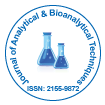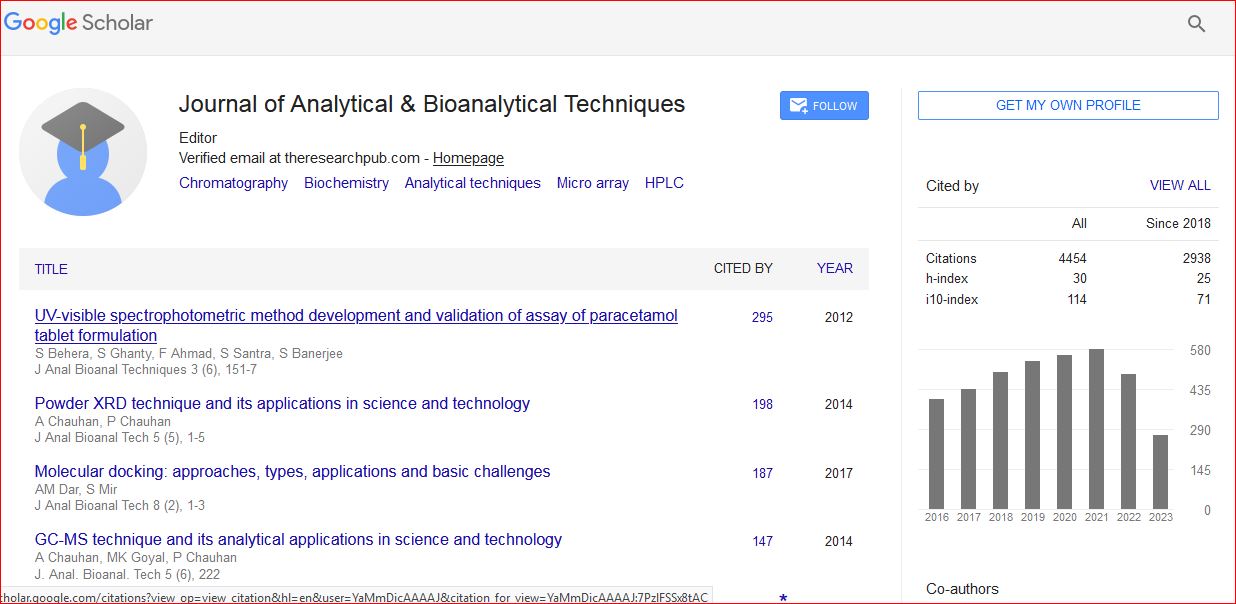Our Group organises 3000+ Global Conferenceseries Events every year across USA, Europe & Asia with support from 1000 more scientific Societies and Publishes 700+ Open Access Journals which contains over 50000 eminent personalities, reputed scientists as editorial board members.
Open Access Journals gaining more Readers and Citations
700 Journals and 15,000,000 Readers Each Journal is getting 25,000+ Readers
Google Scholar citation report
Citations : 6413
Journal of Analytical & Bioanalytical Techniques peer review process verified at publons
Indexed In
- CAS Source Index (CASSI)
- Index Copernicus
- Google Scholar
- Sherpa Romeo
- Academic Journals Database
- Open J Gate
- Genamics JournalSeek
- JournalTOCs
- ResearchBible
- China National Knowledge Infrastructure (CNKI)
- Ulrich's Periodicals Directory
- Electronic Journals Library
- RefSeek
- Directory of Research Journal Indexing (DRJI)
- Hamdard University
- EBSCO A-Z
- OCLC- WorldCat
- Scholarsteer
- SWB online catalog
- Virtual Library of Biology (vifabio)
- Publons
- Euro Pub
- ICMJE
Useful Links
Related Subjects
Share This Page
In vivo and in vitro analysis by Raman-SNOM-AFM imaging and femtosecond spectroscopy �from single cells to humans. Raman diagnostic markers for breast cancer prognosis. New look inside human breast ducts with Raman imaging
6th International Conference and Exhibition on Analytical & Bioanalytical Techniques
Halina Abramczyk, Beata Brozek-Pluska and Jakub Surmacki
Lodz University of Technology, Poland
Posters-Accepted Abstracts: J Anal Bioanal Tech
Abstract
This contribution will explore cutting edge molecular (Raman, fluorescence, SNOM, AFM, TERS, femtosecond spectroscopy) mapping and time resolved dynamics of cellular structures of cancers, localization of drugs and nanoparticles in cells and tissues. The multidisciplinary nature of the studies span a diverse range of biological, chemical, and physical sciences related to cancer biology. This contribution will provide insight regarding Raman Hyperspectral Microscopy technique and its ability to enable rapid optical observation and spectral confirmation of unlabeled biomolecules, drugs, and nanomaterials as they interact with cells and tissue. The main focus will be on the integration of near field microscopy, AFM and hyperspectral Raman imaging technology to look inside human breast ducts to give unambiguous answer about location and distribution of biochemical components in human cells and tissue during cancer development. The contribution shows new look inside human breast duct using Raman imaging, an emerging technology of molecular imaging, that may bring revolution in understanding of cancer biology. Our contribution is a first report in the literature demonstrating such a detailed analysis of normal and cancerous ducts in human breast tissue. The main advantage of Raman imaging is that it gives spatial information about various chemical constituents in defined cellular organelles in contrast to conventional methods (LC/MS, NMR, and HPLC) that rely on bulk or fractionated analyses of extracted components.Biography
Email: halina.abramczyk@p.lodz.pl

 Spanish
Spanish  Chinese
Chinese  Russian
Russian  German
German  French
French  Japanese
Japanese  Portuguese
Portuguese  Hindi
Hindi 
